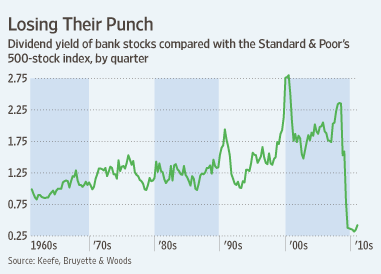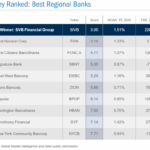During the credit crisis many U.S. banks suspended dividend payments entirely or reduced them significantly. Currently most of the banks pay dividends. But the yields on them is so small that investors are not attracted to them. For example, the current yields of the big four superbanks are follows:
1. JPMorgan Chase (JPM)
Current Dividend Yield: 0.50%
2.Bank of America Corp (BAC)
Current Dividend Yield: 0.33%
3. Wells Fargo (WFC)
Current Dividend Yield: 0.73%
4. Citigroup (C)
Current Dividend Yield: No dividends paid
Compared to the U.S. banks noted above, many foreign banks have high dividend yields. Banco Santander (STD) of Spain pays 5.66%, Deutsche Bank(DB) of Germany yields 1.41% and Westpac Banking Corp(WBK) pays 6.07%. U.S. banks are unable to pay higher dividends due to regulatory restrictions placed on them despite shoring up their capital and rising earnings.But those restrictions are to be lifted according to an article in the Wall Street Journal.
From the article:
“Dividend payments are especially important for banks now that the financial industry’s outlook is clouded by the sluggish economy, toughened regulation and looming capital requirements. But as profits have rebounded, a big-bank stock index from Keefe, Bruyette & Woods Inc. is up 11.6% so far this year after Thursday’s rally, surpassing the Dow Jones Industrial Average’s gain of 9.7%.
While the banks were waiting for the green light to restore their payouts, other companies have been boosting dividends in recent months, making their shares more attractive, especially given the slow growth in the economy. Financials on average yielded 4.4% in 2008, making them one of the highest-yielding sectors, according to Standard & Poor’s. Now they yield 1.1%, making them the second-lowest yielding sector in the market, according to S&P.
Only a handful of banks are expected to meet the Fed’s test, said Frederick Cannon, co-director of research at KBW. Among those with strong enough capital ratios are J.P. Morgan Chase, US Bancorp, State Street Corp. and Bank of New York Mellon Corp., he said.”
The chart above shows the depth of the fall in bank dividend yields. Like utilities, banks traditionally paid high dividends before the financial crisis and were a core holding in income investors’ portfolios. Those investors got burned when these stocks crashed. When banks increase dividends some investors who bailed out may get back in. However there many factors that still make these stocks scary to hold. Hence it is better to keep an eye on this sector and be very selective in any new investments if one wants to add to their portfolio.
Disclosure: Long STD, USB


